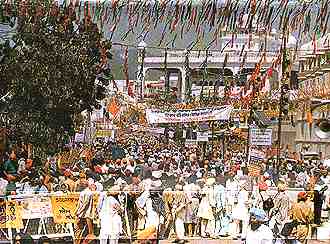The Gurpurab festival is celebrated by the Sikhs to commemorate the Gurus in the month of Kartika (October-November). Guru Nanak, the founder of Sikhism, was born in 1469 at Talwandi-Gujranwala, now called Nankana Saheb and breathed his last in 1539 at Kartarpur. His religion was sternly monotheistic. Through his teachings, he preached the futility of religious vestments, of ostentatious prayer and penance and pilgrimages.
The holy Guru Granth Sahib, the Holy Book, which contains teachings of Nanak, also elaborately deals with both spiritual and worldly affairs and gives emphasis on honesty and spiritual upliftment of all. Guru Nanak through his teach-ings endeavoured to rid both Hinduism and Islam of the superficialities of religion. Endowed with a heart broad enough to embrace both Hindus and Muslims, he strove to bring them together. People of both the sects utter the following words:
'Guru Nanak Shah Fakir, Hindu Ka Guru, Muslim Ka Pir.'
The great Guru emphasised the four ways by which men may reach god. These are: 1. Holy Companionship, 2. Truth, 3. Contentment and 4. Restraint of the senses.
Amritsar, Anandpur, Taran-Taran. Nankana Saheb and Patna are some of the most sacred places to the Sikhs. Amritsar-the Pool of Nectar-is best known as the home of the Golden Temple, the most sacred shrine of the Sikhs. Here, in 1579, Guru Ramdas, the fourth of the Sikh Gurus, decided to build a temple on the land gifted to him by Emperor Akbar. A sacred tank was first excavated and later in 1588, in the midst of it a temple was raised by the fifth Guru, Guru Arjan Dev to house the Guru Granth Sahib, the sacred book of the Sikhs. Ever since, the Darbar Sahib, or Divine Court of Amritsar has been Sikhs' holiest shrine and a pilgrimage centre for Sikhs from all over the world. The temple stands in the centre of the tank. Maharaja Ranjit Singh, as an act of devotion, got the lower half of the temple covered with white marble, while the upper portion was encased with copper and laid over with pure gold leaf. The resulting golden dome and turrets earned the temple the popular name by which it is now known-The Golden Temple. In the sanctuary the holy Granth Sahib rests under a rich canopy and throughout the day ceremonies of worship-recitations, offerings and music-fill the air with devotion.

On the festival day, the Granth Sahib is taken out in procession through the streets of all the cities and towns, prayers are offered at the Gurudwaras and the mahaprasada (a sweet preparation) is distributed to the devotees. For two days and nights the Granth Sahib and the Japji Sahib are read continuously from beginning to end.
The second Gurpurab festival is observed in the month of Pausa (December-January) to celebrate the birth anniversary of Guru Gobind Singh. The festival is celebrated with great zeal and fervour all over the country, and especially at Patna Saheb, the birthplace of the Guru.
The Martyrdom of Guru Arjan Dev and Guru Teg Bahadur is also observed at Gurpurabs. On all such occasions, non-stop recitals of the sacred Granths and religious discourses are held. Free meals (langar) are served to all without any distinction of caste and creed.